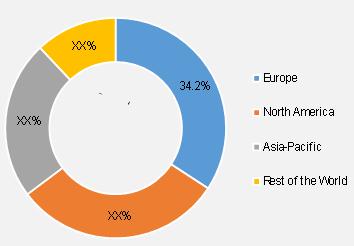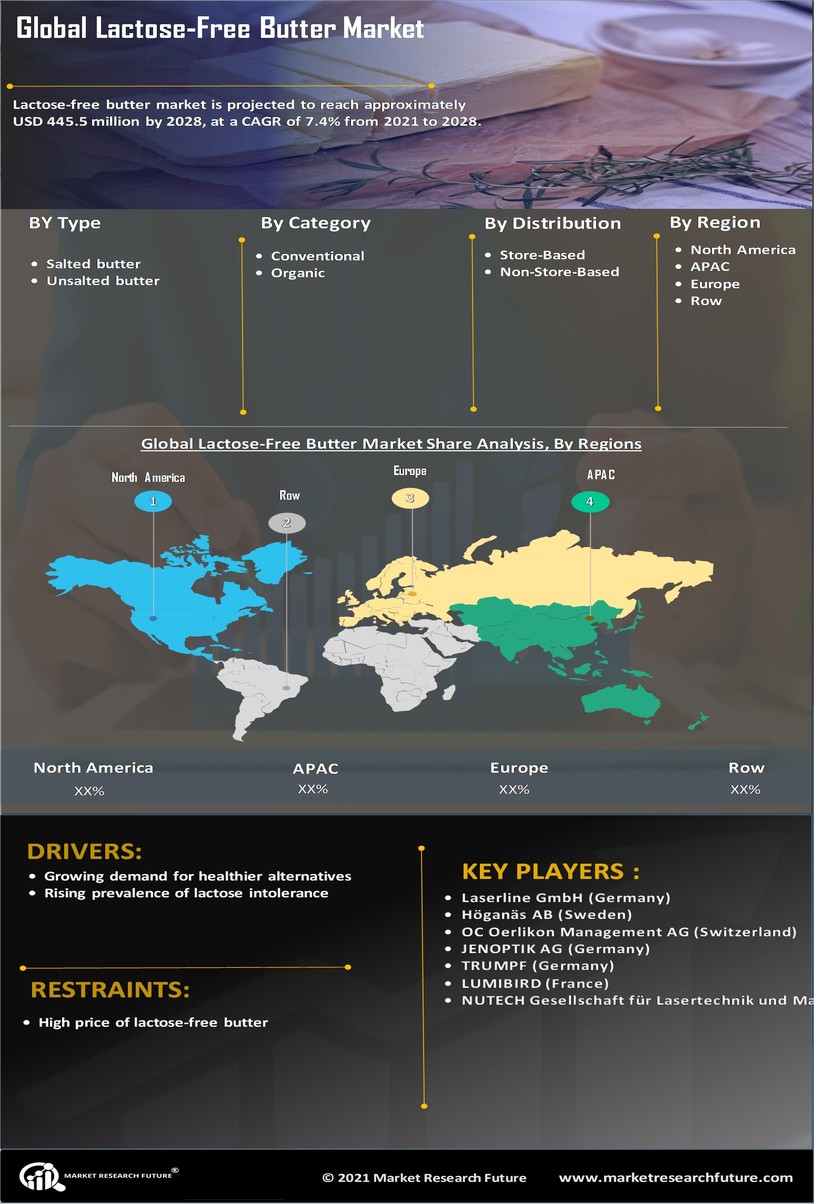Global Lactose-Free Butter Market Overview
Lactose-free butter market Size is projected to reach approximately USD 445.5 million by 2028, at a CAGR of 7.4% from 2021 to 2030.
Owing to this, they have diarrhea, gas, and bloating after eating or drinking dairy products. According to MDPI, the percentage of people with an impaired ability to digest lactose differs extensively depending on the country and continent. For instance, around 98–100% of adults are lactose intolerant in Southeast Asia, and only 1% of adults are lactose intolerant in the Netherlands. However, the awareness of lactose intolerance is increasing over the last few years. Lactose-free products, such as lactose-free butter, help provide essential nutrients present in dairy products to lactose-intolerant people. Lactose-free butter ismade from skimmed milk, concentrated butter, and butter cultures recombined into butter. Lactose is converted enzymatically into glucose and galactose for making the products lactose-free. Different types of lactose-free butter are present in the market, such as salted and unsalted. The growing awareness about lactose intolerance among consumers and the rising vegan population around the world is expected to drive the global lactose-free butter market.
COVID-19 Impact Analysis
The impact of COVID-19 has directly affected the distribution and sales of different products across industries. Many countries were under lockdown and have sealed their borders to curb the spread of the virus. The impact of COVID-19 on logistics has disrupted the supply of raw materials, which has further reduced production capacity and, thus, product shortages. These factors are expected to cause a price rise of lactose-free butter in the short run. Moreover, lactose-free butter is generally purchased to gain the nutritional benefits of milk by lactose-intolerant people. The current pandemic scenario is encouraging consumers to consume products with high nutritional benefits. These factors are directly impacting the supply and demand curve for lactose-free butter.
However, most of the customer's budget was shifted to essential goods, and a major downfall in non-essential businesses was observed. As more cities went into lockdown, non-essential businesses were ordered to remain closed during the first half of the pandemic. Lactose-free butter being a costly product, the demand for the same was affected noticeably.
Market Dynamics
The global lactose-free butter market has witnessed steady growth in recent years. According to a report published by NCBI in 2019, the lactose-free dairy market is the fastest-growing segment in the dairy industry. The global lactose-free dairy is projected to reach around USD 10 billion by 2022 and is expected to continue the growth in coming years. The extensive availability of lactose-free products, a wide product range of lactose-free products, and increasing health awareness among consumers encourage consumers to make lactose-free a preferred choice for dairy. Furthermore, households are often entirely switching to lactose-free dairy products when a single member is lactose intolerant, boosting the growth of the lactose-free butter market. However, the high price of lactose-free butter compared to conventional butter is expected to hamper the market growth during the forecast period.
Drivers
-
Growing demand for healthier alternatives
Consumers have increasingly inclined towards health-benefiting products, providing nutritional benefits and low-fat, low calories products. Lactose-free butter containsa comparatively lower amount of fat and calories. Therefore, the consumers prefer lactose-free butter over dairy butter.
-
Rising prevalence of lactose intolerance
There has been a rise in the number of cases of lactose intolerance across the globe. Lactose intolerant people lack the enzyme lactase in their small intestine, which breaks down lactose into simpler sugars. Lactose intolerance includes an allergy to dairy products, deficiency of disaccharides, and lactase deficiency. Undigested or partially digested lactose leads to abdominal bloating, stomach pain, diarrhea, tiredness, sleep disturbances, vomiting, and other health problems. Estimates for lactose intolerance vary by ethnicity. African, American, and Asian ethnicities see a 75% - 95% lactose intolerance rate, while northern Europeans have a lower rate at 18% - 26% lactose intolerance. The presence of lactose intolerance across the globe has forced people to opt for alternatives to lactose-containing products. This has led to an increased sale of lactose-free butterin recent years.
Restraints
-
High price of lactose-free butter
The natural milk is treated with ultra-high temperature (UHT) method using the pasteurization process for converting it into lactose-free milk. It also helps in increasing its shelf-life and improving the consistency of milk. The normal milk is treated with lactase enzymes for turning to lactose-free milk. Lactase enzymesbreak the complex lactose disaccharide into two simple sugars, namely, glucose and galactose. Thisprocedure of transforming the natural milk into lactose-free milk increases the price of lactose-free products compared to natural packaged dairy products. Owing to this, lactose-free products areconsidered premium products which cater to a smaller consumer population, as the mass population cannot afford them. This acts as a major restraining factor for the lactose-free butter market.
Opportunities:
-
Rising demand for organic products
Organic lactose-free butter is manufactured with organic cream. Organic cream is produced from cream that has been sourced from a cow been fed on organic pastures and raised in an organic environment without the use of any artificial additives. Organic lactose-free butter isa good source of vitamin A and the antioxidant beta carotene. It also comprisesa higher proportion of healthy, unsaturated fats and CLA than regular butter. The growing numbers of allergies and diseases caused by the toxic chemicals used as additives have created awareness for food safety among consumers. Furthermore, the increasing awareness of the health benefits of organic food and beverage products among consumers helps drive the growth ofthe lactose-free butter market. Moreover, the increasing per capita disposable income of the consumers in the emerging economies plays a key role in determining the demand and sales of premium products such as organic lactose-free butter. Therefore, the organic lactose-free butter is expected to create a significant growth opportunity for market players during the forecast period.
-
Non-store-based distribution channels gaining popularity across the globe
The non-store-based segment is expected to register a higher growth rate during the forecast period. Manufacturers of lactose-free butter are inclined towards non-store-based distribution channels for the extensive sales of their products. Due to COVID-19, there has been lockdown in the majority of the countries, resulting in the forced closure of retail stores. Companies opt for online distribution platforms to extend their consumer reach, considering the present situation. Consumers also have access to a wide variety of products in terms of quantity, pack size, and several offers.
Segment Overview
By Type
Based ontype, the global lactose-free butter market has beendivided into salted butter and unsalted butter.The unsalted butter segment is expected to grow fastest with a higher CAGR in the global lactose-free butter market during the period forecasted. Unsalted butter does not contain any added salt. So, unsalted butter has a shorter shelf life than salted butter. However, unsalted butter has a fresher taste. Furthermore, in terms of flavor, unsalted butter has a more pronounced mellow sweetness than salted butter.
By Category
By category, the global lactose-free butter market has been segmented as conventionalandorganic. This conventional segment accounted for the maximum market share in 2020 owing to its low cost and traditional use. Though consumers are increasingly becoming conscious about food safety and sustainable products, the low production cost of conventional variants and lack of awareness regarding organic products is expected to boost the segmental growth during the forecast period.
By Distribution Channel
Based on distribution channel, the global lactose-free butter market has been segmented into store-based and non-store-based. The store-based segment is further divided into supermarkets and hypermarkets, convenience stores, and others. The supermarkets and hypermarkets sub-segment is expected to be the largest as these channels account for the maximum sales of lactose-free butter. Convenience stores also play a significant role in the distribution of lactose-free butter.
Global Lactose-Free Butter Market Share, by Region, 2020 (%) Sources: MRFR Analysis
Sources: MRFR Analysis
Regional Analysis
By region, the global lactose-free butter market has been dividedinto North America, Europe, Asia-Pacific, and the Rest of the World.Europe accounted for the largest market share of 34.2% in 2020. North America was the second-largest market in 2020 and is projected to exhibit an above-average growth rate during the review period.The market in Asia-Pacific is expected to register the highest CAGR during the forecast period.
Europe dominated the global lactose-free butter market in 2020. In Europe, milk is produced in large amounts. The manufacturers in this region are working towards introducing low-cost lactose-free dairy products for fulfilling the demands of the health-conscious population of the region, which has resulted in regional market growth. Moreover, a major consumer shift towards organic food and beverages has been observed in the food and beverages market in the European region forthe past few years. This shift has occurred largely owing to the growing consumer awareness regarding the health benefits provided by organic food and beverages products.
Asia-Pacific is a new revenue pocket for the lactose-free butter market. The increasing consumer awareness about lactose intolerance in the region leads to increasing demand for lactose-free butter. Moreover, the growing demand for healthy food & beverage products, rapid urbanization, and increasing westernization of consumer diets are a few factors driving the growth of lactose-free butter in the region.
Competitive Landscape
The market comprises tier-1, tier-2, and local players. The tier-1 and tier-2 players have reach across the globe with diverse product portfolios. Companies such as Arla Foods amba (Denmark), Green Valley Creamery (US), Johnson & Johnson Services, Inc. (US),and Valio Ltd (Finland)dominate the global market due to brand reputation, product differentiation, financial stability, strategic developments, and diversified regional presence. The players are focused on investing in research &development. Furthermore, they adopt strategic growth initiatives, such as expansion, product launches, joint ventures, and partnerships, to strengthen their market position and capture a large customer base.
Prominent players in the global lactose-free butter market include Arla Foods amba (Denmark), Conagra Brands, Inc. (US), Green Valley Creamery (US), California Dairies, Inc. (US), Valio Ltd (Finland), Upfield (Netherlands), Johnson & Johnson Services, Inc. (US), Lactalis Canada (Canada), OMIRA GmbH (Germany), and Prosperity Organic Foods, Inc. (US).
Scope of the Report
Global Lactose-Free Butter Market, byType
- Salted butter
- Unsalted butter
Global Lactose-Free Butter Market, by Category
Global Lactose-Free Butter Market, by Distribution Channel
-
Store-Based
- Supermarkets & Hypermarkets
- Convenience Stores
- Others
- Non-Store-Based
Global Lactose-Free Butter Market, by Region
-
North America
-
Europe
- UK
- Germany
- France
- Italy
- Spain
- Rest of Europe
-
Asia-Pacific
- China
- India
- Japan
- Australia and New Zealand
- Rest of Asia-Pacific
-
Rest of the World
- South America
- Middle East
- Africa
Intended Audience
- Lactose-Free Butter Manufacturers
- Raw Material Suppliers
- Retailers, Wholesalers, and Distributors
- Governments, Associations, and Industrial Bodies
- Investors and Trade Experts
|
Report Attribute/Metric
|
Details
|
|
Market Size
|
USD 445.5 Million
|
|
CAGR
|
7.4% (2021-2028)
|
|
Base Year
|
2020
|
|
Forecast Period
|
2021-2028
|
|
Historical Data
|
2019
|
|
Forecast Units
|
Value (USD Million)
|
|
Report Coverage
|
Revenue Forecast, Competitive Landscape, Growth Factors, and Trends
|
|
Segments Covered
|
By Product Type, By Category, By Distribution Channel, and By Region
|
|
Geographies Covered
|
North America, Europe, Asia-Pacific, and Rest of the World (RoW)
|
|
Key Vendors
|
Arla Foods amba (Denmark), Conagra Brands Inc. (US), Green Valley Creamery (US), California Dairies Inc. (US), Valio Ltd (Finland), Upfield (Netherlands), Johnson & Johnson Services Inc. (US), Lactalis Canada (Canada), OMIRA GmbH (Germany), Prosperity Organic Foods Inc. (US)
|
|
Key Market Opportunities
|
Growing demand for healthier alternatives
|
|
Key Market Drivers
|
Growing demand for healthier alternatives
|
Lactose Free Butter Market Highlights:
Frequently Asked Questions (FAQ) :
Arla Foods amba (Denmark), Conagra Brands Inc. (US), Green Valley Creamery (US), California Dairies Inc. (US), Valio Ltd (Finland), Upfield (Netherlands), Johnson & Johnson Services Inc. (US), Lactalis Canada (Canada), OMIRA GmbH (Germany), Prosperity Organic Foods Inc. (US)
Lactose-Free Butter Industry Size expected to reach USD 445.5 million By 2028
Lactose-Free Butter Market is anticipated to grow at a 7.4% CAGR during the forecast period of 2021–2028
Europe will be dominant in the lactose-free butter market






 Sources: MRFR Analysis
Sources: MRFR Analysis



















